
Edge colouring is a process by which colour is applied to the edges of the paper. This can be done either by applying ink to the edges of a piece (edge painting) or by applying foil (edge foiling or guilding).
Edge colouring highlights the third dimension of a printed piece, changing it from a flat object into a three dimensional one. Originally reserved for the finest hand-bound books, edge colouring is now often observed on book blocks but also note pads, business cards or invitations.

Tips:
- Design with edge colouring in mind to match and highlight a colour of your design.
- Apply edge colouring when designing on thicker papers or duplexed boards. Edge painting can be done on thinner paper, but heavier paper weights will better show the colour on the edge.
- Ensure the edges of your piece are crisp, clean and dust free. This could be especially tricky if your project includes die-cutting.
- Go for vivid and saturated colours when painting the edge of a card. Edge painting can be done in any colour, including custom-mixed CMYK, Pantone, metallic and fluorescent inks. Pastel shades can also be applied for a softer look.
- Use edge colouring (foil or ink) to hide the edges of duplexed boards if you do not wish the different layers of paper to show. Some printers can also paint spectacular colour gradients on the edges of a print job.
- Keep in mind that edge foiling is more expensive than edge painting.
- Avoid foil stamp or letterpress large areas along the edges, as this would make edge colouring impossible.
- Apply edge colouring to folded or die-cut pieces only after checking with your printer first.
- Apply edge colouring to paper which has been embossed or printed with thermography only after consulting with your printer first. The printed pieces need to pile-up perfectly in order for the edges to be coloured without transferring the surface of the paper too.
- Do notsubstitute edge foiling with painted metallic edges. Metallic inks will not match the shiny, reflective gleam achieved with metallic foils.
- Edge foiling is not limited to gold, silver, bronze or copper. Any type of foil can be used.
- You can also create coloured edges using a triplex with a thick, mass-coloured middle sheet.

